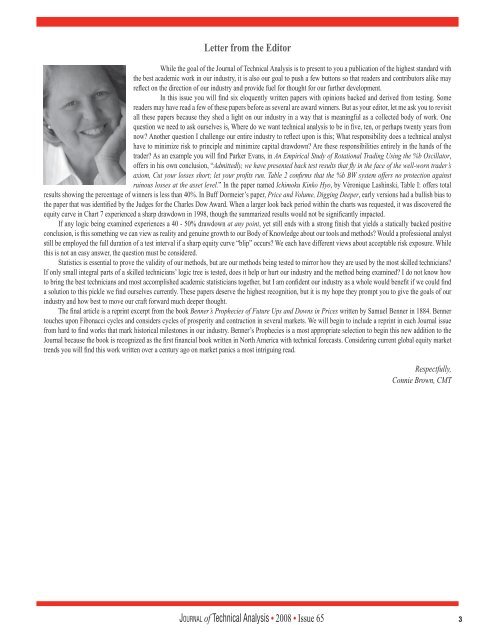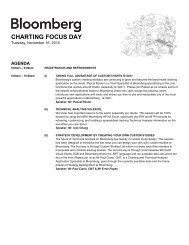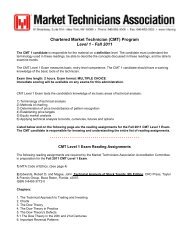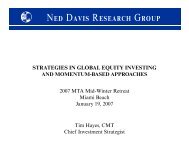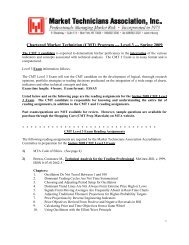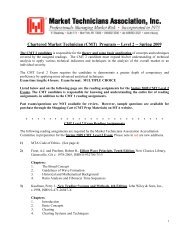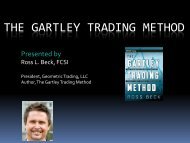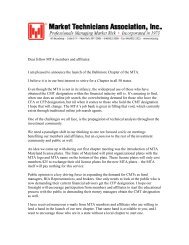Journal of Technical Analysis - Market Technicians Association
Journal of Technical Analysis - Market Technicians Association
Journal of Technical Analysis - Market Technicians Association
Create successful ePaper yourself
Turn your PDF publications into a flip-book with our unique Google optimized e-Paper software.
Letter from the Editor<br />
While the goal <strong>of</strong> the <strong>Journal</strong> <strong>of</strong> <strong>Technical</strong> <strong>Analysis</strong> is to present to you a publication <strong>of</strong> the highest standard with<br />
the best academic work in our industry, it is also our goal to push a few buttons so that readers and contributors alike may<br />
reflect on the direction <strong>of</strong> our industry and provide fuel for thought for our further development.<br />
In this issue you will find six eloquently written papers with opinions backed and derived from testing. Some<br />
readers may have read a few <strong>of</strong> these papers before as several are award winners. But as your editor, let me ask you to revisit<br />
all these papers because they shed a light on our industry in a way that is meaningful as a collected body <strong>of</strong> work. One<br />
question we need to ask ourselves is, Where do we want technical analysis to be in five, ten, or perhaps twenty years from<br />
now? Another question I challenge our entire industry to reflect upon is this; What responsibility does a technical analyst<br />
have to minimize risk to principle and minimize capital drawdown? Are these responsibilities entirely in the hands <strong>of</strong> the<br />
trader? As an example you will find Parker Evans, in An Empirical Study <strong>of</strong> Rotational Trading Using the %b Oscillator,<br />
<strong>of</strong>fers in his own conclusion, “Admittedly, we have presented back test results that fly in the face <strong>of</strong> the well-worn trader’s<br />
axiom, Cut your losses short; let your pr<strong>of</strong>its run. Table 2 confirms that the %b BW system <strong>of</strong>fers no protection against<br />
ruinous losses at the asset level.” In the paper named Ichimoku Kinko Hyo, by Véronique Lashinski, Table I: <strong>of</strong>fers total<br />
results showing the percentage <strong>of</strong> winners is less than 40%. In Buff Dormeier’s paper, Price and Volume, Digging Deeper, early versions had a bullish bias to<br />
the paper that was identified by the Judges for the Charles Dow Award. When a larger look back period within the charts was requested, it was discovered the<br />
equity curve in Chart 7 experienced a sharp drawdown in 1998, though the summarized results would not be significantly impacted.<br />
If any logic being examined experiences a 40 - 50% drawdown at any point, yet still ends with a strong finish that yields a statically backed positive<br />
conclusion, is this something we can view as reality and genuine growth to our Body <strong>of</strong> Knowledge about our tools and methods? Would a pr<strong>of</strong>essional analyst<br />
still be employed the full duration <strong>of</strong> a test interval if a sharp equity curve “blip” occurs? We each have different views about acceptable risk exposure. While<br />
this is not an easy answer, the question must be considered.<br />
Statistics is essential to prove the validity <strong>of</strong> our methods, but are our methods being tested to mirror how they are used by the most skilled technicians?<br />
If only small integral parts <strong>of</strong> a skilled technicians’ logic tree is tested, does it help or hurt our industry and the method being examined? I do not know how<br />
to bring the best technicians and most accomplished academic statisticians together, but I am confident our industry as a whole would benefit if we could find<br />
a solution to this pickle we find ourselves currently. These papers deserve the highest recognition, but it is my hope they prompt you to give the goals <strong>of</strong> our<br />
industry and how best to move our craft forward much deeper thought.<br />
The final article is a reprint excerpt from the book Benner’s Prophecies <strong>of</strong> Future Ups and Downs in Prices written by Samuel Benner in 1884. Benner<br />
touches upon Fibonacci cycles and considers cycles <strong>of</strong> prosperity and contraction in several markets. We will begin to include a reprint in each <strong>Journal</strong> issue<br />
from hard to find works that mark historical milestones in our industry. Benner’s Prophecies is a most appropriate selection to begin this new addition to the<br />
<strong>Journal</strong> because the book is recognized as the first financial book written in North America with technical forecasts. Considering current global equity market<br />
trends you will find this work written over a century ago on market panics a most intriguing read.<br />
Respectfully,<br />
Connie Brown, CMT<br />
Jo u r n a l <strong>of</strong> <strong>Technical</strong> <strong>Analysis</strong> • 2008 • Issue 65 3


